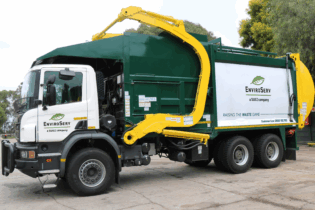South Africa is currently experiencing enormous environmental problems such as degraded soils, polluted groundwater and air, which have led to a serious global problem – greenhouse gas. But earthworm waste management can address these issues.
Gauteng’s abattoir pilot project
by CC Nottingham*
As they are the world’s best natural recyclers of biological waste, earthworms can be used to convert wet waste on a large scale. Their main function when converting waste is to create a pathogen-free micro-organism-rich soil conditioner, which improves soil fertility. Pilot projects have been carried out with Gauteng Provincial Veterinary Health Services on the safe reduction and conversion of abattoir offal and condemned material using earthworms. The large-scale use of earthworm compost and castings (produced from wet waste) can rehabilitate degraded mining and agricultural land in South Africa. Scientific studies have shown that by increasing the life in the soil, erosion is stopped, groundwater is purified, the air is cleaned, and carbon is locked into the soil, where it belongs.
Earthworm facts
It is estimated that there are at least 3 500 species of earthworm throughout the soil on the planet. They are very specific to location, habitat and environmental conditions and can be described according to the level of soil they occupy and their feeding behaviour. According to Bouche, M (1977) earthworm types are described as follows:
- Epigeic types– are surface dwellers living in freshly decaying plant or animal residues.
- Endogeic types –live within soil and feed on degraded organic matter present in the soil.
- Anecic types– burrow deep in the soil but come to the surface at night to forage for freshly decaying residues.
In South Africa we have approximately 300 species; the longest is 3 m and can be found in the Eastern Cape area. Earthworms are hermaphrodites and all are sensitive to UV rays. The earthworm falls under the animal kingdom, not the insect.
Earthworm anatomy
The body structure is basically a hollow tube, albeit very complex. Earthworms use a ‘hydraulic’ system to move around, hence the importance of moisture replacement. The haemoglobin in their blood absorbs oxygen efficiently through the skin. They have no immune system, and this is possibly one of their most important characteristics: they ingest harmful pathogens and digest them in order to grow their own bodies. Their movement in the soil introduces air and helps create an oxygen-rich environment which makes it possible for beneficial bacteria to multiply. Protozoa, bacteria, ciliates, fungi – all these microscopic organisms thrive and push out the anaerobic pathogens, thanks to the role of the earthworm in that environment. It has also been discovered that the earthworm’s excretion is 10 times more nutrient rich than what is ingested, specifically because, due to the presence of beneficial micro-organisms- which are increased 1 000 times while passing through the worm’s gut – food state nutrients (that is, nutrients available to plants) are created.
Analysis of worm castings showed approximately the following when compared to the parent soil:
Table 1: Characteristics of tested soils| Characteristics | |||
| Soil-benevolent Bacteria in ONE worm | Foregut | Midsection | Tail section |
| 475 million | 32 900 million | 474 billion | |
| Available minerals in the soil after earthworm activity: | |||
| Phosphorous | 7 times more | ||
| Nitrogen | 6 times more | ||
| Magnesium | 3 times more | ||
| Carbon | 2 times more | ||
| Calcium | 1.5 times more |
Commercial worm farming
There are three or four species commonly used to create compost and castings on a commercial scale, mostly because of their high rate of reproduction and dense population in enclosed conditions. The other species live in and ingest soil, and need large areas in which to move, therefore creating healthy soil in situ. The most studied earthworm species, widely-used and established world-wide is the Eisenia fetida.
During the Olympic Games in Sydney, Australia, in 2000, all food waste, sewerage and paper products were processed by earthworms. At the Bhawalker Earthworm Research Institute in Pune, India, they have successfully developed waterless earthworm toilets and sewerage treatment facilities. In Minsk, Russia, they reportedly have the largest waste treatment facility using earthworms. Due to the effects of the Chernobyl Nuclear Plant accident about 25 years ago, the Eisenia fetida has become the most-researched earthworm and even the radioactivity in those soils have been found to be best contained by earthworm activity. France and the United States of America also have large-scale earthworm plants.
With the advent of environmental science, born as a result of the impact of environmental degradation, loss of habitat, large-scale extinction of many species, mostly due to our actions, the global environment has our attention. It is in this light that earthworms and their products have become mainstream, and the time has come in South Africa where we are very aware of their importance in maintaining healthy soil, now that the repercussions of ‘dead’ soil have been linked to massive erosion, ground water pollution, large-scale farming failures, adverse weather pattern changes – and even global warming.
Throughout the years, scientists have studied isolated characteristics and effects of earthworms and compost. Many papers have been written, too numerous to mention. At North West University in Potchefstroom, trials have been carried out on the efficacy of earthworms to convert contaminated soils from gold mine tailings dams.
The earthworm and soil life
In the 20 years of my involvement with earthworm farming, the focus has been mainly on the creation of a product – registered with the Department of Agriculture as a ‘group 2 fertiliser’ for the soil. This classification, due to the empirical approach of laboratory analyses, measures but a small window. With the technological advancement of electron microscopy, and its application to soil analysis – a whole new world has opened up to us – the complex web of life of micro-organisms and hence a greater, complete picture of soil life, health and the resulting environmental consequences have emerged. Thanks are due to Dr Elaine Ingham and the International Soil FoodWeb Institute. In summary, earthworms live in and convert biological waste into a soil-enhancement product – discovered due to the role of the micro-organisms. Earthworm products are classified as follows:
– vermicompost and vermicastings from the breakdown of organic matter (mainly plant matter and manures)
– liquid leachates or worm tea/wee
– worm bins of varying sizes and shapes (domestic, commercial, large-scale farming)
– doggie-loos, and others.
Safe management of abattoir waste
Initial enquiry 2006
Based on some articles that were written in 2005 and 2006, I was approached by Dr Soni and Dr Louro of the Gauteng Veterinary Health Services, who at the time were compiling a Guideline Manual for Abattoirs. This meeting was about the use of earthworm technology to manage abattoir waste. This has led to an interesting journey where the focus is not only the management of a toxic, hazardous and extremely pollutant waste, but the possibility of its conversion into an environmentally-safe (pathogen-free), and therefore usable, soil conditioner.
Pilot research 1: June, July 2006
Armed with this question, we immediately set upon experimenting on a small scale – in two plastic boxes approximately 600 x 300 x 350 mm. Although this was carried out with the sanction of the Veterinary Health Services, it took three months to obtain 1 kg of carcass meal and 1 kg of blood meal from an abattoir due to the red tape involved, especially when it was for something ‘outside the box’.
The first results registered a failure in that within a short space of time, all the earthworms turned either luminous yellow from the carcass meal, or a deep red from the blood meal, and all of them died. The obvious conclusion was that earthworms are not carnivores. They do not ‘eat’ the matter itself, but rather go for the micro-organisms that are present in decaying matter. In this case, the fat and the blood then needed to be pre-digested by micro-organisms to be made ‘safe’ for the earthworms.
Pilot research 2: October 2006
The next step was to compost the carcass meal and the blood meal for a period of time, and then earthworms were introduced. Although they hesitated to move in, they eventually settled in. Our conclusion was that by ensuring the presence of micro-organism activity, earthworm composting was possible, but we needed to up the scale.
Pilot research 3: 2007 – 2008
Then followed months of delay. Because we wanted to do everything above board, as we were working in conjunction with Gauteng Province, we approached a reputable abattoir and the local environmental departments, both municipal and provincial, to request permission for our official pilot to take place. The Department of Environment kept shifting us from one person to another, we could not get anyone to, firstly, determine how much abattoir offal we could transport and use in the pilot (our request was for 1 t), and, secondly, find a person/department that would grant us that permission. It was the same with the local municipalities’ environmental departments. We had the land and the methodology and, through Gauteng Veterinary Services, we had access to testing from the Onderstepoort Labs. However, we needed the permission to run a pilot.
Presentations, written motivations and requests to the various departments eventually resulted in written responses that we would not be granted permission to run a pilot without first undergoing an Environmental Impact Assessment. It was not feasible for us to do this for the small quantities involved to run a pilot test. We were totally stumped and turned back to Gauteng Veterinary Health. After deliberation, the State Vet himself (Dr Louro) and his colleague, Dr Soni, gave us written permission sanctioning our actions. But the pilot was limited to half a tonne of offal and, instead of the numerous tests that would be done by Onderstepoort Labs, they would do only two: for Ecoli 0157 and Salmonella.
Concurrent to this, we decided to run an unofficial trial on our own. We ‘found’ 500 kg of offal from a small abattoir (to remain unnamed), mixed it with manure and greens, and composted it for a few months.
Regular temperature, moisture and pH readings were taken. This was then fed to the earthworms with moderate success. Moderate because as it was an unofficial pilot, the results carried little weight.
During this time, however, (2007 and 2008) I was regularly invited to be a guest speaker at many abattoir-government-related conferences and open days in Gauteng, Mpumalanga, Limpopo, and the Northern Cape. We also had a hearing at the Gauteng Legislature in May 2008. The word, or rather the ‘worm’, was spreading–several large abattoirs had started composting their offal, instead of the usual practice of burying or landfilling it. The National Environmental Management Bill was grinding its way towards becoming an Act.
Official pilot 4: 2008-2009
This pilot is the thesis for an Honours Degree by a Gauteng Vet, Jack Motshegoa and his thesis subject was approved at the end 2008. In February 2009, armed with the necessary letters of permission, signed undertakings and Memorandums of Understanding between the various provincial and municipal departments, as well as the ‘official’ abattoir and ourselves, we collected the 500 kg offal and set up the pilot. Tests were carried out by Ondestepoort, Nvirotek Labs and the Soil FoodWeb Institute. The results were handed to an expert on compost (Mr Dahan) and his conclusion was that ‘it is a good product’.
Table 2: Summary of tests conducted| 1-3 months | At month 2 | At month 3 | |
| COMPOST mixture | First Lab tests | Lab tests | Lab tests |
| Total Weight (kg) | Daily readings: | ||
| Total Volume (litres) | Moisture | ||
| pH | |||
| Temperature | |||
| EARTHWORM mixture | SFI test | ||
| Total volumes – compost, water | |||
| Earthworms weighed | |||
Conclusion
NEMA (National Environmental Management Act) 2009
According to the Waste Hierarchy (below), NEMA has opened the doors for different thinking to take place across all walks of life, from industry and commerce to domestic, as each section of society has to find every means possible to prevent (or at least to minimise) disposal to landfill. This opens up many opportunities for renewable operations to establish themselves.
Table 3: Waste hierarchy| CLEANER PRODUCTION | Prevention | |
| Minimisation | ||
| RECYCLING | Re-use | |
| Recovery | ||
| Composting | ||
| TREATMENT | Physical | |
| Chemical | ||
| Destruction | ||
| DISPOSAL | Landfill | |
Recycling, conversion and treatment of various ‘wet’ waste streams
On a very small budget, and therefore rather informally, it has been proven that earthworms can be a vital link in the reduction of certain wastes that would normally either go to landfill or be buried, namely abattoir offal, manure and sewage, and vegetative matter.
Rehabilitation of degraded lands
In addition, NEMA places the responsibility on the owners of land to rehabilitate the land after use to “its former state”. Whether or not this seems possible or feasible, it nevertheless opens many opportunities for doing things differently. The Global Carbon Credit Exchange platform is just one such means to link recycling and treatment (prevention of disposal) of major existing waste streams through the use of Earthworm Technology, and also help clean up degraded lands with the resulting product.
ACKNOWLEDGEMENTS
Dr Louro and Dr Soni of the Gauteng Department of Agriculture, Conservation and Environment (Veterinary Public Health) – in asking the question of whether or not earthworms can be used to recycle abattoir waste – have initiated the exploration and helped make possible the findings of this project.
Although no sponsorship has been received, the project has continued for four years as the basis of a feasibility study for the business Earthworm Waste Management. This is a Section 21 Company, whose mission is to rehabilitate the environment (land, air and water) through earthworm waste management and thereby positively impact society. Its aim is the reduction and management of wet or biological waste to become the leaders in environmental regeneration.
*Living Earth







